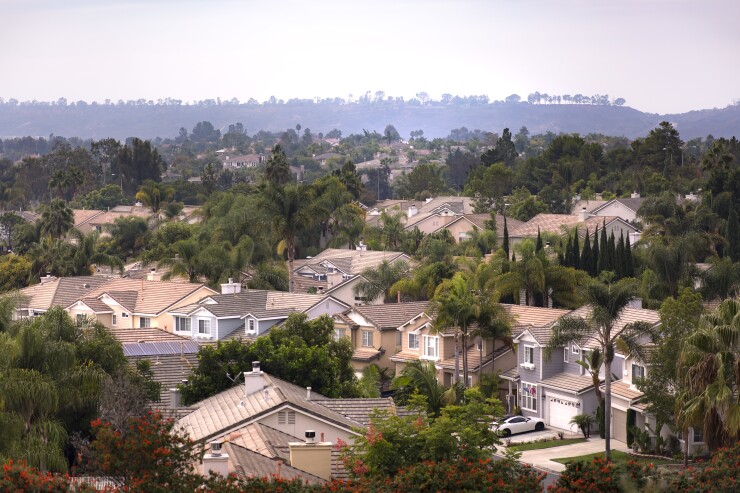The San Diego region has no shortage of homes next to fire-prone hillsides covered in highly flammable chaparral and grasslands. The undulating, arid topography has carried flames at mind-boggling speeds in some of the state's most destructive blazes.
Now elected officials in the county want to add another roughly 10,000 homes in areas largely labeled by Cal Fire as posing a "very-high" fire hazard.
Those units would come in the form of eight new sprawling housing projects, which have drawn widespread opposition and even lawsuits.
While the development, county supervisors have said the housing is badly needed and that, in each case, developers have laid out exhaustive fire-prevention blueprints.

Elected officials have stressed that those plans are reviewed and approved by local fire districts or Cal Fire.
"I take every decision I make very seriously and always rely heavily on the feedback provided by our fire experts, the firefighters," said board chair Kristin Gaspar in an email.
Environmental groups, who have opposed the projects on a number of grounds, renewed their attacks in November following what became the state's most deadly and destructive blaze, Northern California's Camp Fire.
"It's a huge risk putting thousands of live in these areas where we know fire is going to happen," said Tiffany Yap, an advocate with the Center for Biological Diversity, which estimates the projects would put as many as 40,000 people in danger of wildfire.
County staff declined several requests for interviews on the topic, citing ongoing litigation against the projects that have already received needed amendments to the county's 2011 general plan -- Newland Sierra, Valiano, Harmony Grove Village South and Otay 250 Sunroad.
Supervisor Dianne Jacob, being absent for the votes in question, is the only member of the board not to vote to approve the projects. She said that changes to established zoning rules must be weighed against wildfire risk.
"The county's general plan, our guiding document on land-use issues, was overhauled a few years ago and now steers future development to existing communities with well-established services," she said in an email. "It guards against sprawl in remote areas and aims to minimize losses in any disaster."
According to experts, California's building codes and planning strategies have come a long way in recent years to protect homes from wildfire. Specifically, homes built since 2008 in fire-prone areas that abut wildlands have been required to include features, such as vents designed to stop embers, dual-paned and tempered windows, as well as fire-resident roofs, walls and doors.
The state also requires residents to maintain defensible space around a home's perimeter by removing flammable materials, including brush and other vegetation. Exact rules can very as some municipalities, such as San Diego County, have stricter provisions.
Many communities, notably in Rancho Santa Fe, Ramona and Julian, have been able to stave off the worst impacts of wildfire thanks to these upgrades and practices, said Christopher Dicus, a professor of wildland fires and fuels management at California Polytechnic State University.
"You can reduce the heat exposure to the home, but more important is preparing the homes to the ember attacks that are going to ensure under Santa Ana winds," he said. "All it takes it one ember that can travel literally miles in front of the make fire front."
He said the research community doesn't fully understand how to prevent embers from burning down the house.
"When these embers are coming out it's not like little ambers, they're like softballs blowing at 60 miles an hour slamming against homes, literally billions looking for any sort of nook and cranny they can get into," he said.
At the same time, experts said that too often homeowners become complacent about chopping back fast-growing vegetation or leave flammable items renting against their homes. Enforcing the rules consistently over time can be difficult given limited resources and sprawling housing conditions.
Cal Fire San Diego turned down numerous interview requests for this story.
What these building code and other rules don't take into account is whether a particular project should be built at all, said Max Moritz, a cooperative extension specialist in wildfire at the Bren School at UC Santa Barbara.
"There's all these hazards that we use to guide our building and our zoning from floods to landslides, and fire is not one of them," Moritz said.
"In the end, the taxpayer is left holding the bill for all this," he added. "The developer may do a really good job at designing and convincing everybody that it's the right thing to do, but after they walk away, the public is left doing fuels maintenance for decades, and the public picks up the bill when there's a disaster."
Many of the fire-protection plans for the proposed developments in San Diego County include sophisticated measures, including large swathes of defensible space, walls to block potential flames and strategically irrigated landscapes.
Michael Huff, a principal senior urban forester with Dudek, said his company has designed several of the blueprints for the current projects, including Newland Sierra and Harmony Grove Village South.
He said he goes so far as to model wind conditions on a localized scale when designing a fire plan.
"Every site that we work on in San Diego is different," he said. "It's based on everything from the location to the fuel types to the exposure to the winds.
Huff said that in some cases he has turned down work because a project could not, in his estimation, be built safely. However, he declined to call out any such developments in particular because they are likely still seeking approval.
"I'd rather not say too much about them because they may still be active trying to get through, and I don't want to put any attention on them," he said.
In an email, county staff said the agency has denied about 20 proposed subdivisions since 2009 based on wildfire concerns related to building codes.





